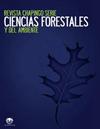气候变化及其对瓦哈卡云雾林树种分布的影响
IF 0.6
4区 农林科学
Q3 Agricultural and Biological Sciences
Revista Chapingo Serie Ciencias Forestales Y Del Ambiente
Pub Date : 2022-04-30
DOI:10.5154/r.rchscfa.2021.02.008
引用次数: 1
摘要
气候变化是一个产生长期影响的问题,被认为对许多物种的保护构成威胁。目的:评价气候变化对瓦哈卡州云雾林10种特有树种分布面积的影响。材料和方法:在Had GEM2-ES大气环流模式下,对两个时间范围(2050年和2080年)和两个排放情景(RCP 4.5和8.5)的影响进行了评估。当前和未来的分布是用MaxEnt建模的。通过对植物标本室标本的整理,得到了热带杉木、梨形胡桃木、枫香木、白玉兰、白玉兰、山茱萸、红豆杉和红豆杉的分布。结果与讨论:在rcp4.5中,梨形j.s ririformis, L. styraciflua, L. glaucescens和S. coccinea的分布面积增加了(2.8% ~ 20.5%)。在这种情况下,与目前的分布相比,其余物种的面积减少了30%。在RCP 8.5 ~ 2050中,梨形蠓和维吉尼亚蠓的增势均在5%以上。在RCP 8.5-2080情景下,所有物种的减少幅度均大于10%。模型曲线下面积大于0.8,部分ROC (Receiver Operating Characteristic)大于1.7。结论:了解10种物种对气候变化的响应将作为提出保护和监测计划的基础,因为其中9种物种处于某种风险类别。本文章由计算机程序翻译,如有差异,请以英文原文为准。
Climate change and impact on distribution of tree species in the cloud forest of Oaxaca
Introduction: Climate change represents a problem that generates long-term impacts and is considered a threat to the conservation of many species. Objective: To evaluate the impact of climate change on the distribution areas of 10 trees species characteristic of cloud forests in the state of Oaxaca. Materials and methods: The impact was evaluated for two-time horizons (2050 and 2080) and two emission scenarios (RCP 4.5 and 8.5) under the Had GEM2-ES general atmospheric circulation model. Current and future distribution was modeled with MaxEnt. The distribution of Carpinus tropicalis, Juglans pyriformis, Liquidambar styraciflua, Litsea glaucescens, Magnolia dealbata, Magnolia schiedeana, Ostrya virginiana, Symplocos coccinea, Zinowiewia concinna and Taxus globosa were obtained from the herbarium specimen review. Results and discussion: In RCP 4.5, J. pyriformis, L. styraciflua, L. glaucescens and S. coccinea increased (2.8 % to 20.5 %) their area of distribution. In this scenario, the rest of the species reduced their area by up to 30 % compared to the current distribution. In RCP 8.5-2050, J. pyriformis and O. virginiana had a gain of more than 5 %. All species showed a reduction greater than 10 % under the RCP 8.5-2080 scenario. The models showed area under the curve greater than 0.8 and partial ROC (Receiver Operating Characteristic) greater than 1.7. Conclusions: Understanding the response of 10 species to climate change will serve as a basis for proposing conservation and monitoring plans, since nine of them are in some category of risk.
求助全文
通过发布文献求助,成功后即可免费获取论文全文。
去求助
来源期刊
CiteScore
1.20
自引率
16.70%
发文量
0
审稿时长
>12 weeks
期刊介绍:
The Revista Chapingo Serie Ciencias Forestales y del Ambiente (RCHSCFA) is a scientific journal that aims to raise awareness of high-quality research products related to forest, arid, temperate and tropical environments in the world. Since its foundation in 1994, the RCHSCFA has served as a space for scientific dissemination and discussion at a national and international level among academics, researchers, undergraduate and graduate students, forest managers and public/private entities that are interested in the forest environment.
All content published in the journal first goes through a strict triple-blind review process and is published in the following formats: Scientific Articles, Review Articles, Methodologies, Technical or Technological Notes.

 求助内容:
求助内容: 应助结果提醒方式:
应助结果提醒方式:


